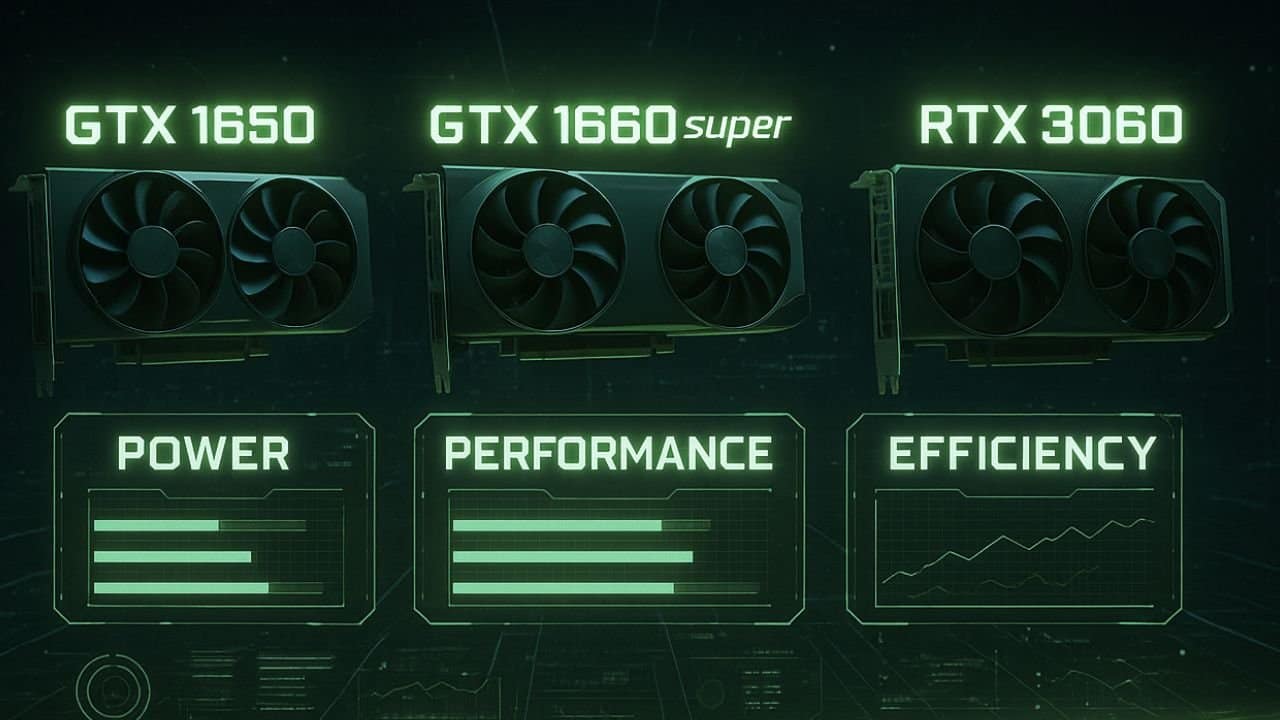Table of Contents
When you’re building or upgrading a gaming PC, one of the hardest decisions is picking the right GPU. For beginners, the names can feel overwhelming: GTX 1650, 1660 Super and RTX 3060, and even Ti versions. Which one should you buy? Which card is worth it in 2025?
This guide compares them side by side with specs, real gaming performance, and prices across US and EU. Whether you’re a casual gamer, budget builder, or someone planning for the future, this blog will make it easy.
Release Dates & Architecture
- GTX 1650: Launched Apr 22, 2019, built on Turing (TU117) with 896 CUDA cores and 4 GB GDDR5. Reference models (75W) draw all power from the PCIe slot (no 6‑pin needed).
- GTX 1650 Ti (Mobile): Primarily a laptop GPU released in early 2020. It is Turing based (TU117) with about 1024 cores and 4 GB GDDR6, 55W TDP (no external connector).
- GTX 1660 Super: Launched Oct 29, 2019, Turing (TU116) with 1408 cores and 6 GB GDDR6 memory (14 Gbps). It is essentially a GTX 1660 with faster GDDR6 RAM. TDP 125W (8-pin PCIe power).
- GTX 1660 Ti: Launched Feb 22, 2019, Turing (TU116) with 1536 cores, 6 GB GDDR6, 120W TDP requiring one 8‑pin power cable.
- RTX 3060: Launched Feb 25, 2021, Ampere (GA106) with 3584 cores and 12 GB GDDR6 (192-bit). TDP 170W (needs one 8‑pin/12‑pin connector).
- RTX 3060 Ti: Launched Dec 2, 2020, Ampere (GA104) with 4864 cores and 8 GB GDDR6. TDP 175W (8‑pin/12‑pin).
These GPUs differ in power consumption and thermals and knowing what’s safe for your GPU temps is crucial.
Specifications
| GPU | CUDA Cores | VRAM | Bus |
|---|---|---|---|
| GTX 1650 | 896 | 4 GB GDDR5 | 128-bit |
| GTX 1650 Ti | 1024 | 4 GB GDDR6 | 128-bit |
| GTX 1660 Super | 1408 | 6 GB GDDR6 (14 Gbps) | 192-bit |
| GTX 1660 Ti | 1536 | 6 GB GDDR6 (12 Gbps) | 192-bit |
| RTX 3060 | 3584 | 12 GB GDDR6 (15 Gbps) | 192-bit |
| RTX 3060 Ti | 4864 | 8 GB GDDR6 (14 Gbps) | 256-bit |
*1650 Ti is mobile only (included for completeness)
Gaming Performance Benchmarks
In practice these cards perform roughly as their specs suggest. The older GTX 16-series handle entry level 1080p gaming, while the RTX 30-series are much stronger. For example:
- Fortnite (1080p, Epic settings): The GTX 1650 gets only 40–45 FPS, whereas the GTX 1660 Ti can reach 75 FPS. The RTX 3060 easily exceeds 100 FPS (often with headroom due to DLSS/more power).
- GTA V (1080p, Ultra): The RTX 3060 can run GTA V at 154 FPS, while older GTX cards reach 30–80 FPS depending on model. (For reference, at 4K Ultra the 3060 still managed 56 FPS vs 33 FPS on the 1650.)
- Cyberpunk 2077 (1080p, RT Off): The RTX 3060 averages 55 FPS, but the GTX 1650 is very low (8–9 FPS). The mid-tier 1660 Super/Ti hit 15–25 FPS (still under 60).
- Shadow of the Tomb Raider (1080p, High): In GPU-monkey tests, the GTX 1660 Ti and 1660 Super score around 79–80 FPS, while the RTX 3060 scores 80 FPS and the 3060 Ti 93 FPS. The weaker GTX 1650 averages around 50 FPS in this game (not directly cited).
In Short
Modern, demanding games like Cyberpunk show the largest gaps, the RTX 3060/3060 Ti are far smoother than GTX 16-series. In lighter or older games (Fortnite, GTA V, Tomb Raider) the 1660 Super/Ti hold 60+ FPS, but the 1650 only hovers around 40–50 FPS. RTX features (DLSS/RT) on Ampere can further improve RTX 3060 series performance.
Price Comparison
Current market prices vary by region. As per (Best Value GPU)
| GPU | USA | EU |
|---|---|---|
| GTX 1650 | $249 | €213 |
| GTX 1660 Super | $179 | €340 |
| GTX 1660 Ti | $179 | €399 |
| RTX 3060 12GB | $299 | €259 |
| RTX 3060 Ti | $359 | €421 |
Note:
Newer RTX cards (3060 series) still carry higher prices due to demand. The older GTX 16-series often sell for their (lower) launch MSRP or as used parts. Prices fluctuate rapidly, so check local retailers.
What’s Great / What’s Not
GTX 1650 (Turing, 4GB):
| What’s Great | What’s Not |
| Very low power draw (75W, often no external cable), affordable, decent for eSports/older titles. Good for tiny or budget builds. | Only 4GB VRAM (limiting for new games), no ray tracing, just entry-level 1080p performance (40–50 FPS in modern games). |
GTX 1650 Ti (laptop):
| What’s Great | What’s Not |
| Better mobile performance than 1650, still low power. | Still only 4GB, no desktop version, mid-level performance (around 50+ FPS in many games |
GTX 1660 Super (Turing, 6GB):
| What’s Great | What’s Not |
| Great 1080p midrange card; outperforms 1650 by 60–70% in many games. Uses fast 14Gbps GDDR6 (336 GB/s bandwidth). Good value for tight 1080p budgets. | No ray tracing or DLSS. 6GB VRAM is sufficient for now but not future-proof (some games want 8GB). |
GTX 1660 Ti (Turing, 6GB):
| What’s Great | What’s Not |
| Slightly faster than 1660 Super (1536 vs 1408 cores). Handles 1080p/1440p well (see benchmarks: SOTR 80 FPS). Good stepping stone after the 1060. | Higher price at launch than 1660 Super. Still no ray-tracing. |
RTX 3060 (Ampere, 12GB):
| What’s Great | What’s Not |
| Modern 1080p/1440p performance with DLSS/RTX support. 12GB VRAM is ample for current games. For example, it hits 154 FPS in GTA V and 55 FPS in Cyberpunk 2077. Good balance of price and power (MSRP $329). | Still requires 170W and a power cable. Outperformed by 3060 Ti. |
RTX 3060 Ti (Ampere, 8GB):
| What’s Great | What’s Not |
| Strongest of this group. Nearly matches last-generation RTX 2080 Super. It yields very smooth 1080p/1440p gaming (e.g. 93 FPS in SOTR). Supports all Ampere features (RT cores, DLSS) and launched at $399 (higher-end). Great for future games. | Only 8GB VRAM (8GB is borderline for future 4K). Requires 200W PSU. More expensive. |
What We Think…
Best for ultra-tight budgets: The GTX 1650 (or 1650 Super if available) is the cheapest solution. It will run popular eSports titles (Fortnite, CS:GO, Overwatch) above 60 FPS at 1080p, but it struggles in heavy AAA games. Its low power draw means you might even skip a PCIe power cable (the reference card is 75W). In regions where used cards are common, a second-hand 1660 Super or Ti (each $179 used) often offers much better performance for the price.
Best value for money: A GTX 1660 Super hits a sweet spot: it’s usually well-priced ($179 used) and performs close to a 1660 Ti. It can play most new games at 1080p high settings comfortably. If you can stretch a bit, the RTX 3060 (12GB) provides a big jump: ray tracing and DLSS support, plus more VRAM (12GB) for only a couple hundred dollars more. In short, GTX 1660 Super is great if you need to save money, while RTX 3060 is strong value if your budget allows the extra.
Most future-proof: For longevity and highest settings, the RTX 3060 Ti is the winner. It outclasses all GTX 16-series cards by a large margin (e.g. 127% faster than the 1650 in Fortnite). Its ample performance headroom and support for Ampere features mean it can handle upcoming game demands. The trade-offs are higher cost ($359) and power use (200W). The RTX 3060 (non-Ti) is the runner-up: still Ampere, still decent for years to come, but slower.
Base vs Ti versions: The “Ti” models (1660 Ti, 3060 Ti) always have more CUDA cores and usually slightly higher clocks than their base counterparts. This yields 15–20% higher performance (e.g. the 1660 Ti’s 1536 cores vs 1660 Super’s 1408 cores). The base 1660/3060 cards often have the same memory bus but lower core count; the Super versions may just use faster memory (like 1660 Super vs 1660). In practice, Ti variants are faster but cost a bit more.
In Short
- If you’re building a very cheap rig, go with a GTX 1650 or 1660 Super. You’ll get playable 1080p in many games, but don’t expect Ultra settings in the newest titles.
- For balanced performance and price, the RTX 3060 is a solid midrange pick, it can still do 1080p/1440p well and unlocks modern tech (DLSS).
- If you have a higher budget or want longevity, the RTX 3060 Ti is the way to go (and will handle future games best).
Each card has its sweet spot. Check your budget and use-case: eSports gamers on a shoestring lean toward the 1650/1660 Super, while AAA gamers who want maximum FPS or ray-tracing should aim for the 3060 Ti or 3060.

